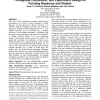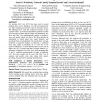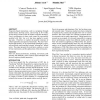16 search results - page 1 / 4 » Refining Fitts' law models for bivariate pointing |
CHI
2003
ACM
14 years 5 months ago
2003
ACM
We investigate bivariate pointing in light of the recent progress in the modeling of univariate pointing. Unlike previous studies, we focus on the effect of target shape (width an...
CHI
2011
ACM
12 years 8 months ago
2011
ACM
Fitts’ law (1954) characterizes pointing speed-accuracy performance as throughput, whose invariance to target distances (A) and sizes (W) is known. However, it is unknown whethe...
CHI
2011
ACM
12 years 8 months ago
2011
ACM
Recently, Wobbrock et al. (2008) derived a predictive model of pointing accuracy to complement Fitts’ law’s predictive model of pointing speed. However, their model was based ...
CHI
2008
ACM
14 years 5 months ago
2008
ACM
For decades, Fitts' law (1954) has been used to model pointing time in user interfaces. As with any rapid motor act, faster pointing movements result in increased errors. But...
CHI
1997
ACM
13 years 9 months ago
1997
ACM
Trajectory-based interactions, such as navigating through nested-menus, drawing curves, and moving in 3D worlds, are becoming common tasks in modern computer interfaces. Users’ ...



